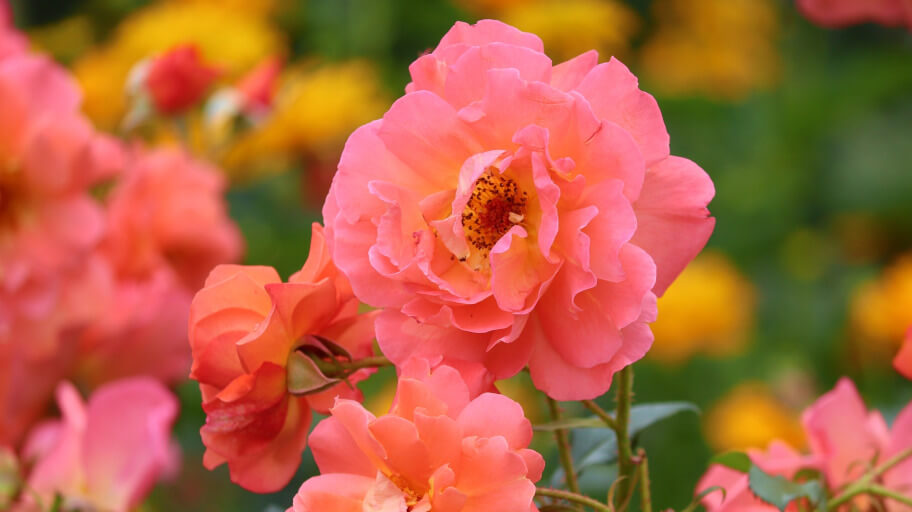There are millions of insects in Australia alone and while some can be beneficial for your garden, other are quite destructive. Fortunately, gardeners can keep away and manage these detrimental insects with simple, organic pest control solutions.
While there is no shortage of insects that are bad for your garden, we’ve used our experience in gardening to narrow them to 29 common garden pests and we’ve given brief tips on how to identify and get rid of them using non-toxic methods.
Aphids (Aphidoidea)

There are more than 4000 aphid species, and around 250 of them are considered as pests for crops. You can recognize these critters by their little, pear-shaped bodies with long antennae and a pair of abdominal tubes called cornicles. Depending on species, they vary in colour and may be white, green, yellow, brown, black, or even pink. Two widespread species in Australia are the cotton aphid and the cabbage aphid, and because of their wide distribution on the continent, they are also common garden pests.
Damage and Symptoms of aphid infestation
Aphids feed on fruits, vegetables, ornamentals, and variety of other plants by sucking sap of phloem vessels.
To identify an aphid infestation:
 Look for curled leaves, yellowing, browning, unusual leaf drop, or stunted growth. Aphids can usually be spotted on tips of new growth and leaf undersides.
Look for curled leaves, yellowing, browning, unusual leaf drop, or stunted growth. Aphids can usually be spotted on tips of new growth and leaf undersides. Check the leaves and stems for a sticky liquid substance. It’s called “honeydew” which is produced by the aphids and can be a sign for the presence of these insects. Keep an eye for ants on your plants as well, because this sugary liquid attracts them.
Check the leaves and stems for a sticky liquid substance. It’s called “honeydew” which is produced by the aphids and can be a sign for the presence of these insects. Keep an eye for ants on your plants as well, because this sugary liquid attracts them. Examine the leaves and branches of your crops for black spots. It could be sooty mould which benefits from the honeydew secreted from sap-sucking insects, such as aphids.
Examine the leaves and branches of your crops for black spots. It could be sooty mould which benefits from the honeydew secreted from sap-sucking insects, such as aphids.
Organic Control Measures for Aphids
Aphids are able to reproduce rapidly and can quickly become a serious problem for your garden. To get rid of these garden pests, we suggest the following eco-friendly solutions:
 You can efficiently get rid of small aphid colonies by simply crushing the insects by hand or prune the affected area of the plant.
You can efficiently get rid of small aphid colonies by simply crushing the insects by hand or prune the affected area of the plant. Use a strong spray of cold water to rinse the affected plants. Make sure to rinse the undersides of leaves because aphids hide there.
Use a strong spray of cold water to rinse the affected plants. Make sure to rinse the undersides of leaves because aphids hide there. Attract beneficial insects, such as lady beetles, lacewings and parasitic wasps, which will devour aphids. Read more here.
Attract beneficial insects, such as lady beetles, lacewings and parasitic wasps, which will devour aphids. Read more here. Apply tomato leaf or garlic spray.
Apply tomato leaf or garlic spray. Use a spray with horticultural oil or insecticidal soap. (For severe infestations)
Use a spray with horticultural oil or insecticidal soap. (For severe infestations)
African Black Beetle (Heteronychus arator)
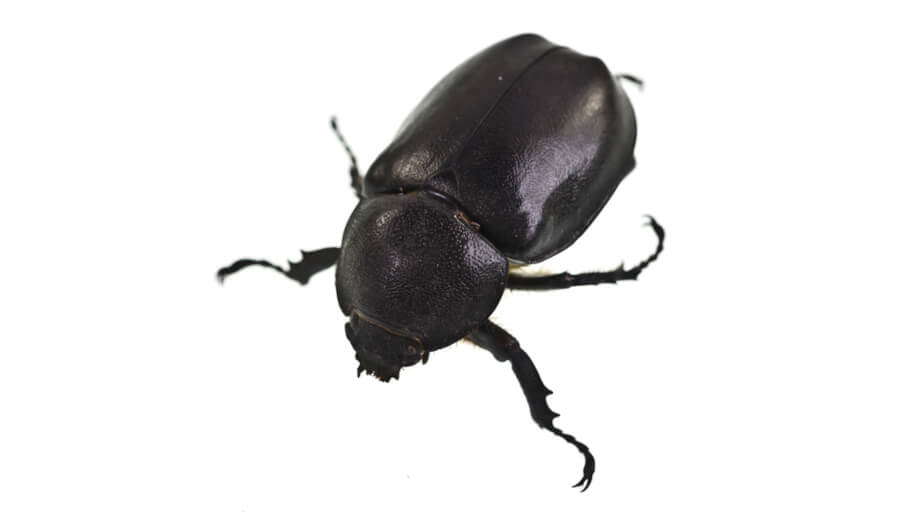
This beetle has been accidentally introduced in Australia from South Africa (as the name suggests). The African Black Beetle occurs mainly in Western Australia and the wetter coastal south-eastern regions up to South East Queensland. African black beetle larvae is creamy-white, except for their light brown head, and grow up to 25mm in length. Adults are brown to shiny black and about 12 to 14mm long.
Damage and Symptoms of African black beetle infestation
Both adults and larvae are considered as pests that can affect the establishment of a wide variety of plants including ryegrass, maize, turf, grapevines, olives, ornamental plants, and vegetable crops, most preferred of which are potatoes. The African black beetle feeds on roots and underground stems of young plants causing the death of the plant. To identify whether your garden is attacked by these pests, look for:
 Suckers emerging from young plants. This might be a sign for the presence of African black beetles. Examine the soil near the base of the plants for beetles.
Suckers emerging from young plants. This might be a sign for the presence of African black beetles. Examine the soil near the base of the plants for beetles. Vine foliage that has turned red or yellow prematurely.
Vine foliage that has turned red or yellow prematurely. Wilted potato stems and damaged potato tubers.
Wilted potato stems and damaged potato tubers. Dead patches in lawns.
Dead patches in lawns.
Organic Control Measures for African black beetles
Although, the African black beetle is difficult to control without chemicals, there are several non-toxic measures you can take to protect your garden plants:
 Build physical barriers. Growguards can be an effective solution against African black beetle adults if buried to about 5cm. For treelings, you can wrap the root ball along most of the stem with plastic mesh sleeve.
Build physical barriers. Growguards can be an effective solution against African black beetle adults if buried to about 5cm. For treelings, you can wrap the root ball along most of the stem with plastic mesh sleeve. A clever way to deal with these clumsy walkers is to plant into slightly raised angled beds covered with plastic mulch.
A clever way to deal with these clumsy walkers is to plant into slightly raised angled beds covered with plastic mulch. Use domestic birds, such as chickens and ducks, as a natural way to control not only beetles but other garden pests as well.
Use domestic birds, such as chickens and ducks, as a natural way to control not only beetles but other garden pests as well.
Australian plague locust (Chortoicetes terminifera)
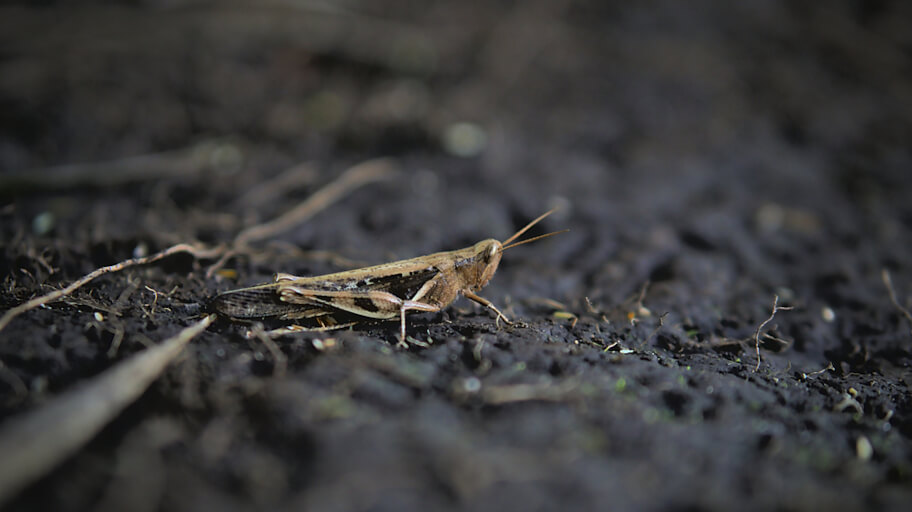
The Australian plague locust is a major insect pests of crops and pastures throughout Australia. Active from spring to autumn, locusts may enter home gardens and can quickly build up to high numbers because of the concentration of irrigated plants and cause severe damage.
Adult Australian plague locust are grey to brown or occasionally green in colour, 25-44mm long, with black tipped rear wings and red shanks on the hind legs.
If you notice a swarm of locusts in your garden, you need to act immediately. Since locusts are certain species of short-horned grasshoppers, you can use same control strategies as for grasshoppers. You can also apply biological control agent derived from an Australian fungus called Metarhizium anisopliae that attacks locusts and grasshoppers.
Azalea Lace Bug (Stephanitis pyrioides)

Azalea lace bugs live and feed on the undersides of azalea and rhododendron leaves. They grow no more than 6mm long. Adults are cream-coloured with flattening lace-like forewings that extend beyond the body outline. In Australia, the azalea lace bug can be found throughout the eastern states and ACT.
Damage and Symptoms
This kind of lace bugs is known to be very aggressive. Just in a year, every azalea plant in your garden could be infested if proper measures are not taken. The azalea lace bugs use their piercing mouthparts to suck the sap from the leaves. If your azaleas are infested with lace bugs, you might notice:
 Chlorotic stippling effect visible on the upper leaf surface.
Chlorotic stippling effect visible on the upper leaf surface. Entire leave and even entire plants to have bleached or bronze appearance due to a heavy infestation. Plants damaged to this degree don’t grow and don’t bloom well.
Entire leave and even entire plants to have bleached or bronze appearance due to a heavy infestation. Plants damaged to this degree don’t grow and don’t bloom well.
Note: Both of the above symptoms are often mistaken for spider mite damage so when you see those signs it is important to take a closer look. Flip leaves over and check their undersides for adult or immature lace bugs.
 Little black spots on the underside of the foliage is another sign of lace bug infestation.
Little black spots on the underside of the foliage is another sign of lace bug infestation.
Organic Control Measures
A number of organic methods are available to deal with azalea lace bugs:
 For a small number of lace bugs, use a strong jet of water from a garden hose to knock the pests of the plant and possibly kill the nymphs. Prune the damaged foliage.
For a small number of lace bugs, use a strong jet of water from a garden hose to knock the pests of the plant and possibly kill the nymphs. Prune the damaged foliage. Use natural predators to get rid of Azalea lace bugs. Lacewings, a native predator found throughout southern Australia, has proven to be a reliable control option for lace bugs. Other beneficial insects that help keep lace bugs under control include lady beetles, assassin bugs, pirate bugs, and predatory mites.
Use natural predators to get rid of Azalea lace bugs. Lacewings, a native predator found throughout southern Australia, has proven to be a reliable control option for lace bugs. Other beneficial insects that help keep lace bugs under control include lady beetles, assassin bugs, pirate bugs, and predatory mites. Use horticultural oil, neem oil, or insecticidal soap to kill adults and larvae population. Spray the plant one time every two weeks by applying the spray to the undersides of leaves.
Use horticultural oil, neem oil, or insecticidal soap to kill adults and larvae population. Spray the plant one time every two weeks by applying the spray to the undersides of leaves.
Bronze Orange Bug (Musgraveia sulciventris)

The bronze orange bug, also known as stink bug is considered a pest to all citrus trees. They suck the sap out from young shoots, fruits and flowers causing wilting and premature fruit drop. When dealing with these pests be extremely careful as they emit foul-smelling liquid that will burn skin and eyes on contact.
How to Identify a Bronze Orange Bug
Active in the warmer months, bronze orange bugs are not difficult to be identified. They first appear in late winter as lime green nymphs no longer than 6mm. As they grow they change colour into orange to bronze, and eventually becoming brown to black and reaching 25mm when fully grown. Native to Australia, this pest can be found in Queensland and New South Wales in Eastern Australia.
Organic Control Measures
The best time to control and manage bronze orange bugs is in the early spring while they are still nymphs. Here are some organic control methods to get rid of these stink bugs:
 Spray Eco-Oil every 10-14 days during winter and early spring to kill the nymphs before they have developed into adults. The time to apply this remedy is essential as the Eco-Oil is not efficient against adult stink bugs.
Spray Eco-Oil every 10-14 days during winter and early spring to kill the nymphs before they have developed into adults. The time to apply this remedy is essential as the Eco-Oil is not efficient against adult stink bugs. Spray your ornamental citrus with Neem-oil. Gardeners who have used it for other garden pests have reported good results for bronze orange bugs as well.
Spray your ornamental citrus with Neem-oil. Gardeners who have used it for other garden pests have reported good results for bronze orange bugs as well. Use an old vacuum cleaner to suck up the bugs.
Use an old vacuum cleaner to suck up the bugs. Squash the bugs between planks of wood.
Squash the bugs between planks of wood. Drown them into a soapy water or methylated spirit. Pick up the bugs with tongs or by hand. The best time to collect the insects is on hot days when the bugs will gather on the lower trunk of the tree where it is cooler.
Drown them into a soapy water or methylated spirit. Pick up the bugs with tongs or by hand. The best time to collect the insects is on hot days when the bugs will gather on the lower trunk of the tree where it is cooler.
Make sure to wear gloves, protective glasses, long sleeves and a hat to protect your skin and eyes against the caustic liquid these bugs eject.
Cabbage Moth (Plutella xylostella) and Cabbage White Butterfly (Pieris rapae)
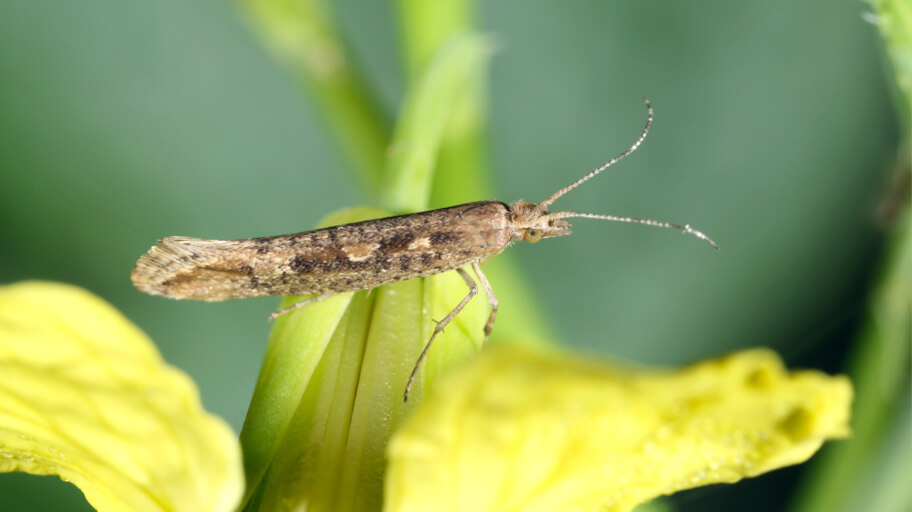

The caterpillars laid by the cabbage moth and the cabbage white butterfly are common pests in the veggie garden. Both the moth and the white butterfly lay their eggs on the underside of leaves. They prefer plants from the family Brassicaceae, such as broccoli, cabbage, chinese cabbage, watercress, mustard and brussel sprouts. Once hatched, the larvae start feeding on the leaves or fruits of their host plant.
How to Identify Them
Adult cabbage white butterflies are white with black spots on the wings with a wingspan of about 45mm, while the larvae is velvety green with faint yellow stripes and spots along the body. The cabbage moth is greyish and about 10mm long. Its caterpillars are green in colour. To identify the presence of these insect pests in your garden, look for:
 Large holes in outer leaves;
Large holes in outer leaves; Dark green droppings on leaves;
Dark green droppings on leaves; Discolouration of the heads of the cauliflower and broccoli, which is caused by the caterpillars’ excrement.
Discolouration of the heads of the cauliflower and broccoli, which is caused by the caterpillars’ excrement.
Organic Control Measures for Both
There is a number of organic methods to control and get rid of these garden pests:
 Enhance the environment for the natural predators of caterpillars, such as ladybirds, assassin bugs, lacewings, paper wasps.
Enhance the environment for the natural predators of caterpillars, such as ladybirds, assassin bugs, lacewings, paper wasps. Provide nest sites around your garden to attract insect-eating birds.
Provide nest sites around your garden to attract insect-eating birds. Pick the caterpillars by hand and either squash them or feed them to the chooks.
Pick the caterpillars by hand and either squash them or feed them to the chooks. Place vegetable mesh on top of your plants to prevent eggs being laid on them.
Place vegetable mesh on top of your plants to prevent eggs being laid on them. Cut white ice-cream or yogurt containers in the shapes of butterflies and put them on stakes around your garden. The white cabbage butterfly and the cabbage moth are territorial insects and they avoid places where the competition for food may seem high.
Cut white ice-cream or yogurt containers in the shapes of butterflies and put them on stakes around your garden. The white cabbage butterfly and the cabbage moth are territorial insects and they avoid places where the competition for food may seem high. Plant land cress, Barbarea vulgaris, somewhere in the garden. This plant attracts these butterflies and moths to lay their eggs on it. The leaves are toxic to the caterpillars, and when they hatch, you can count them dead.
Plant land cress, Barbarea vulgaris, somewhere in the garden. This plant attracts these butterflies and moths to lay their eggs on it. The leaves are toxic to the caterpillars, and when they hatch, you can count them dead. Plant herbs such as dill, basil, fennel coriander and sage. These herbs’ strong smell confuses the cabbage white butterfly.
Plant herbs such as dill, basil, fennel coriander and sage. These herbs’ strong smell confuses the cabbage white butterfly. Use Bacillus thuringiensis. It is organic bio-insecticide that can effectively control these pests.
Use Bacillus thuringiensis. It is organic bio-insecticide that can effectively control these pests.
Christmas Beetle (Anoplognathus pallidicollis)
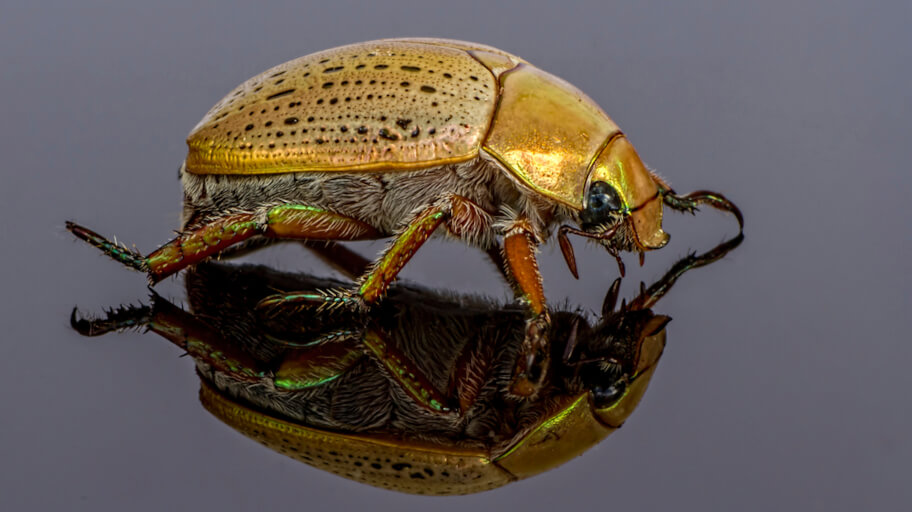
Christmas beetles are widely distributed throughout Australia. The larvae of the Christmas beetle live in the soil and feed on grass roots, while the adults are leaf-eating and attack most eucalypt species. Active between November and February, grown Christmas beetles can devastate newly established eucalypt plantations and isolated trees within a few days because of their swarming behaviour.
How to Identify Christmas Beetles
Identifying these scarabs is easy because of their shiny exoskeleton. The adult beetles are large, about 25-30mm long. Depending on the species, their colour vary from yellow-brown to red-brown. The damage they cause is visible as jagged, ripped leaves.
Organic Control Measures for Christmas Beetles
The control of this pest is difficult because of the quickness with which these beetles defoliate a tree and move on to the next. Monitor your trees carefully and take action before the damage becomes severe. You can try and knock them off the tree with a strong jet of water, collect them in plastic sheets and destroy them later as suggested here.
Keep in mind that by the time damage is noticeable it is usually too late to take effective action.
Citrus Gall Wasp (Bruchophagus fellis)
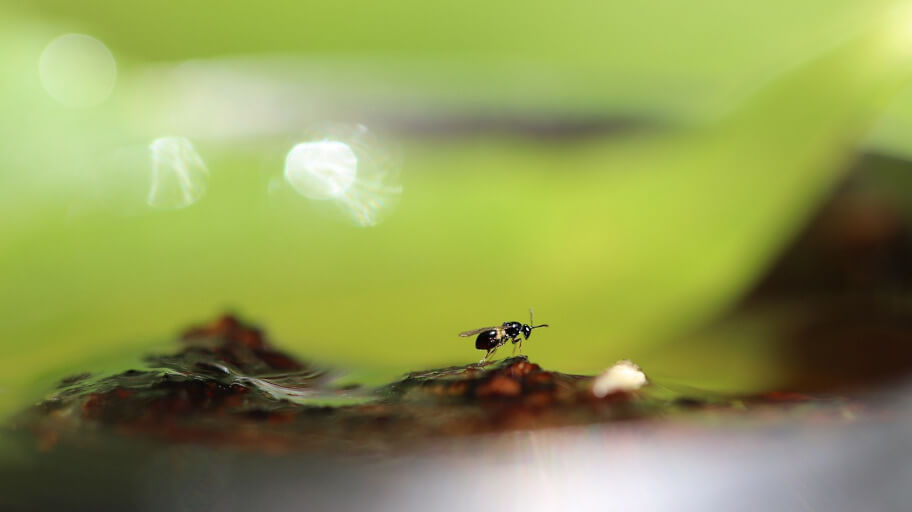
Citrus gall wasp is an Australian native garden pest which natural host is the Australian finger lime but all citrus varieties can be attacked. Most susceptible are lemons, grapefruits, oranges and rootstocks. The wasp lays its eggs into the stems of citrus trees. Once larvae hatch, they start feeding on the stem tissue, causing woody galls that can weaken trees, which may result in reduced yield, and in case of a heavy infestation, branch dieback.
How to Identify a Citrus Gall Wasp
Citrus gall wasp adults emerge around October. They are shiny black and about 3mm long. The life span of the adult wasps is about a week during which a female can lay up to 100 eggs. Eggs are usually laid under the bark of young spring shoots. When monitoring for citrus gall wasp infestation, search for the presence of galls on young, green twigs. The monitoring is best to be done between June and September when you can easily detect the galls.
Organic Control Measures for Citrus Gall Wasps
Getting rid of citrus gall wasp can be difficult but damage can be minimized by:
 Pruning out branches affected by newly formed galls. Seal the branches in plastic bags and throw them in the rubbish, or better burn or mulch them. Before pruning make sure there are no signs of exit holes on the galls. Exit holes mean that the wasps have already left the gall and removing the branch would be meaningless.
Pruning out branches affected by newly formed galls. Seal the branches in plastic bags and throw them in the rubbish, or better burn or mulch them. Before pruning make sure there are no signs of exit holes on the galls. Exit holes mean that the wasps have already left the gall and removing the branch would be meaningless. Opening the galls with a razor blade and killing the larvae inside has proven to be a successful method when pruning is not an option. This method is not recommended when the normal emergence period is too close as the wasps can emerge from the cut galls.
Opening the galls with a razor blade and killing the larvae inside has proven to be a successful method when pruning is not an option. This method is not recommended when the normal emergence period is too close as the wasps can emerge from the cut galls. Avoiding over-fertilizing in spring as this promotes excessive spring flush which attracts the adult citrus gall wasps.
Avoiding over-fertilizing in spring as this promotes excessive spring flush which attracts the adult citrus gall wasps. Hanging yellow sticky traps in the lower canopy of the infected trees. Place the traps in mid-August before the adult wasps start emerging, and remove them in early December when wasps are no longer to prevent trapping beneficial insects.
Hanging yellow sticky traps in the lower canopy of the infected trees. Place the traps in mid-August before the adult wasps start emerging, and remove them in early December when wasps are no longer to prevent trapping beneficial insects. Introducing parasitic wasps which are natural enemies of the citrus gall wasps.
Introducing parasitic wasps which are natural enemies of the citrus gall wasps.
Citrus Leafminer (Phyllocnistis citrella)
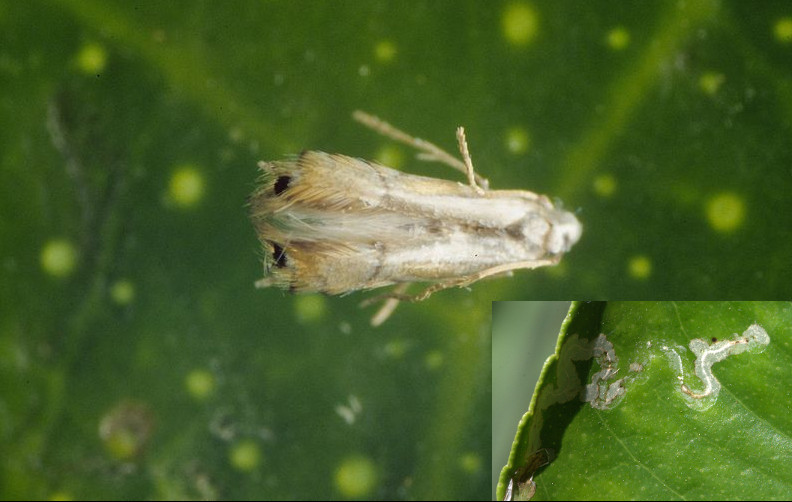
Citrus leafminer is a small silvery-white moth with a wingspan of only 5mm. Its larvae are considered a serious pest on citrus trees of all kinds. After hatching, the leafminer larvae mine their way through the leaves leaving silvery trails and causing the leaves to twist and curl. Severe infestations can stunt young tree’s growth and reduce yield.
Look for the following symptoms to identify citrus leafminer infestation:
 silver trails on the leaf surface;
silver trails on the leaf surface; distorted and curled leaves;
distorted and curled leaves;
Organic Control Measures for Citrus Leafminers
To control infestations on home garden trees, you can take the following action when the pest is first noticed:
 Remove any affected leaves that might be hiding pupae. Do not use these leaves for compost or you risk to create a breeding ground for more leafminers! Instead, place the leaves in plastic bags and leave them out in the sun.
Remove any affected leaves that might be hiding pupae. Do not use these leaves for compost or you risk to create a breeding ground for more leafminers! Instead, place the leaves in plastic bags and leave them out in the sun. Spray with horticultural oil to prevent the moth from laying new eggs. This won’t kill the larvae, so sprays should be applied before too many eggs have been laid.
Spray with horticultural oil to prevent the moth from laying new eggs. This won’t kill the larvae, so sprays should be applied before too many eggs have been laid. Attract natural enemies, such as parasitic wasps and lacewings, to your garden.
Attract natural enemies, such as parasitic wasps and lacewings, to your garden.
You can reduce infestations by:
 avoiding over fertilising and irrigating during summer and autumn to limit flush growth;
avoiding over fertilising and irrigating during summer and autumn to limit flush growth; fertilising in winter to promote flush growth in spring when the citrus leafminer is rarer.
fertilising in winter to promote flush growth in spring when the citrus leafminer is rarer.
Codling Moth (Cydia pomonella)

Codling moth is a major insect pest on pome fruits and can devastate the entire crop if not controlled. Damage is caused by the larvae which tunnel into the fruit core where they feed on the developing seeds for 3-5 weeks then burrow out leaving a brown rotting mess. Codling moth prefers apples, pears, quinces and crab apples.
How to Identify Codling Moths
The adult codling moth is about 1 cm long, grey-brown with several grey cross-lines on the forewings. The larva is white with a black head. The first generation of moths emerges in early spring about the time of bloom. Females lay their eggs on leaves usually near fruit. After the caterpillars’ hatch, they may feed on leaves for a while before burrowing into the fruit. When they leave the fruit, they form cocoons in a hidden place. This might be in a crevice, under loose bark, or in the ground. When the cocoons hatch, the cycle repeats. There is usually two to three generation per season in Australia.
To identify codling moth larvae infestation, look for:
 Holes and frass (reddish-brown droppings) on the outside of the fruit.
Holes and frass (reddish-brown droppings) on the outside of the fruit. If the larvae have penetrated the fruit from the calyx or stem end, detection is not possible without cutting open the fruit.
If the larvae have penetrated the fruit from the calyx or stem end, detection is not possible without cutting open the fruit.
Organic Control Measures for Codling Moths
Controlling the population of codling moth might be a difficult and slow process. Usually, you will need to combine several strategies to handle the problem with this pest. Some organic measures are:
 Do winter clean-up by scraping loose bark from trees and maintaining general orchard hygiene to reduce the survival of over-wintering populations.
Do winter clean-up by scraping loose bark from trees and maintaining general orchard hygiene to reduce the survival of over-wintering populations. Wrap cardboard or a band of cloth around the trunks of trees to lure the grubs that emerge from the fruits looking for place to pupate. Check these traps every two months and destroy any cocoons and caterpillars you might find there.
Wrap cardboard or a band of cloth around the trunks of trees to lure the grubs that emerge from the fruits looking for place to pupate. Check these traps every two months and destroy any cocoons and caterpillars you might find there. Spray your trees with a solution of white oil and water (dilution ratio 1:50) when the weather gets warmer (around 15C+). The solution will prevent the eggs from hatching. Apply the spray regularly at weekly intervals.
Spray your trees with a solution of white oil and water (dilution ratio 1:50) when the weather gets warmer (around 15C+). The solution will prevent the eggs from hatching. Apply the spray regularly at weekly intervals. Inspect the trees regularly when fruit appears. Collect any infested fruits (including the fallen one) and destroy them either by submerging them in water for several days or placing them in plastic bags and leaving them in the sun. Do not compost infested fruits!
Inspect the trees regularly when fruit appears. Collect any infested fruits (including the fallen one) and destroy them either by submerging them in water for several days or placing them in plastic bags and leaving them in the sun. Do not compost infested fruits! Attract beneficial insects, such as predatory wasps, Australian earwigs, ladybirds, lacewings and other beneficial bugs, by planting insectary plants like mustard, clover, dill, coriander, cosmos and buckwheat. The natural enemies of codling moth will help you keep its population in control.
Attract beneficial insects, such as predatory wasps, Australian earwigs, ladybirds, lacewings and other beneficial bugs, by planting insectary plants like mustard, clover, dill, coriander, cosmos and buckwheat. The natural enemies of codling moth will help you keep its population in control. Place removable fences around separate trees and release chooks to clean-up fallen fruit and cocoons.
Place removable fences around separate trees and release chooks to clean-up fallen fruit and cocoons.
Keep in mind that you may have little or no success controlling the codling moth in your garden if the neighbouring trees are infested.
European Earwig (Forficula auricularia)
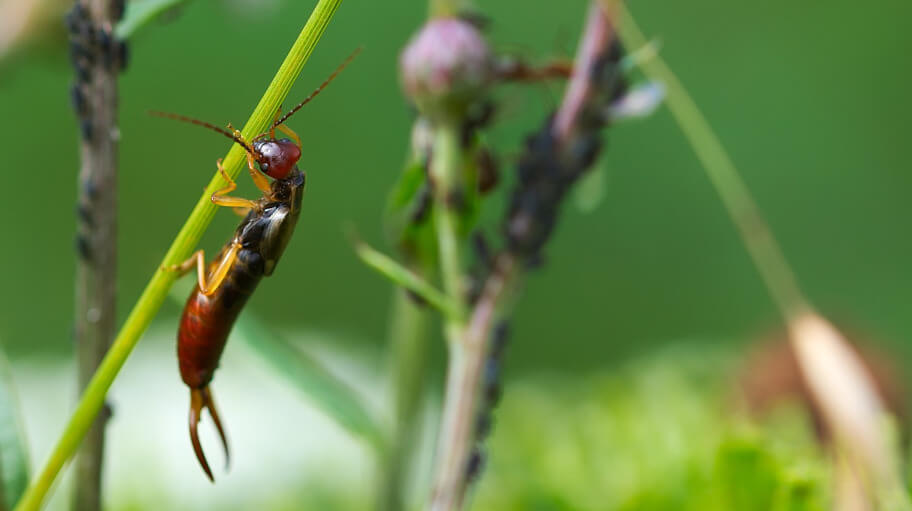
Earwigs are omnivores and can feed on almost anything from organic matter, fruits, ornamental plants, vegetables, flowers, and seed to live and dead insects, including caterpillars and other earwigs. Most Australian native earwigs are not known to damage crops and some of them are considered beneficial as they attack a variety of garden pests. However, the European earwig can be a serious pest of broadacre crops when the population builds up. It attacks mainly canola, cereals, lupins and some legume crops, but it can also damage flowers, fruits and vegetables.
How to Identify a European Earwig
Correctly identifying earwig species is important because they each have different roles as pests or beneficial species. Adult European earwigs range from 12 to 24 mm in size. They have reddish-brown heads, and smooth, shiny brown bodies with yellowish legs, 'shoulders' and pincers (also called forceps). They are nocturnal and shelter in dark places during the day.
Earwigs can cause the following damage to your plants:
 jagged holes in the leaves or shredded leaf tips;
jagged holes in the leaves or shredded leaf tips; completely defoliated young seedings in case of severe infestation;
completely defoliated young seedings in case of severe infestation; damage to fruit resembles one of birds or slugs and snails.
damage to fruit resembles one of birds or slugs and snails.
Organic Control Measures for European Earwigs
To control the earwigs in your garden:
 Clean up any garden debris and rubbish to reduce available refuges.
Clean up any garden debris and rubbish to reduce available refuges. Set up a trap by placing dampen newspaper in a pot turned upside down. Earwigs will crawl into the pot.
Set up a trap by placing dampen newspaper in a pot turned upside down. Earwigs will crawl into the pot. Pour linseed oil in several food containers with lids filling about 3-4mm above the bottom of the containers. Make a few 5mm holes into the containers’ sides above the oil’s level and place the containers around the plants being attacked. This trap has proven to be quite efficient against earwigs.
Pour linseed oil in several food containers with lids filling about 3-4mm above the bottom of the containers. Make a few 5mm holes into the containers’ sides above the oil’s level and place the containers around the plants being attacked. This trap has proven to be quite efficient against earwigs. Earwigs are attracted by beer but they die once they taste it. Pour some beer in small jars and lay the jars on their sides.
Earwigs are attracted by beer but they die once they taste it. Pour some beer in small jars and lay the jars on their sides. Use scooped out orange halves or crumpled up newspapers to trap earwigs. Collect them first thing in the morning and knock them into a bucket of soapy water.
Use scooped out orange halves or crumpled up newspapers to trap earwigs. Collect them first thing in the morning and knock them into a bucket of soapy water. Sophie Thomson, a presenter for ABC’s Gardening Australia, in one of her columns recommends pouring a little vegetable oil into a saucer or shallow dish and follow with a drizzle of soy sauce as the best trap for earwigs.
Sophie Thomson, a presenter for ABC’s Gardening Australia, in one of her columns recommends pouring a little vegetable oil into a saucer or shallow dish and follow with a drizzle of soy sauce as the best trap for earwigs.
Fruit fly

Fruit flies are a significant threat to horticulture. These insect pests can infect a wide variety of fruits and vegetables and destroy them. In Australia, there are two fruit fly species that are of major concern to home gardeners and commercial fruit growers - Queensland fruit fly (Bactrocera tryoni) and the Mediterranean fruit fly (Ceratitis capitata).
Damage and Symptoms of Fruit Fly Infestations
Female fruit flies lay their eggs beneath the skin of the fruit. The larvae referred to as maggots, start feeding on the fruit flesh as soon as they hatch causing the fruit to rot and drop. The grown maggots shelter in the soil, where they pupate. Depending on the species, fruit flies are most active from September through to May.
Look for the following signs in your garden to identify a possible fruit fly infestation:
 Adult fruit flies flying around fruits and vegetables.
Adult fruit flies flying around fruits and vegetables. Puncture wounds, such as dimpled fruit flesh, weeping, or bacteria infected sites, caused by the stings of the female fruit flies.
Puncture wounds, such as dimpled fruit flesh, weeping, or bacteria infected sites, caused by the stings of the female fruit flies. Maggots in fruit. They would be white or creamy-white in colour and about 5-10mm long.
Maggots in fruit. They would be white or creamy-white in colour and about 5-10mm long.
Organic Control Measures for Fruit Flies
To control fruit flies in your garden we suggest the following organic strategies:
 Collect all infested fruit. To kill the maggots, put the damaged fruit in a plastic bag, seal it, and leave it in the sun. Alternatively, boil the fruits and feed your poultry with them.
Collect all infested fruit. To kill the maggots, put the damaged fruit in a plastic bag, seal it, and leave it in the sun. Alternatively, boil the fruits and feed your poultry with them. Let chooks in your orchard to aid fruit fly control by dealing with pupating in the soil.
Let chooks in your orchard to aid fruit fly control by dealing with pupating in the soil. Use pheromone traps to lure and kill male flies before they mate. Unmated females won’t sting your fruits.
Use pheromone traps to lure and kill male flies before they mate. Unmated females won’t sting your fruits. Use protein-based baits to catch both male and female fruit flies.
Use protein-based baits to catch both male and female fruit flies. Enclose individual fruits inside paper bags.
Enclose individual fruits inside paper bags.
Grasshoppers
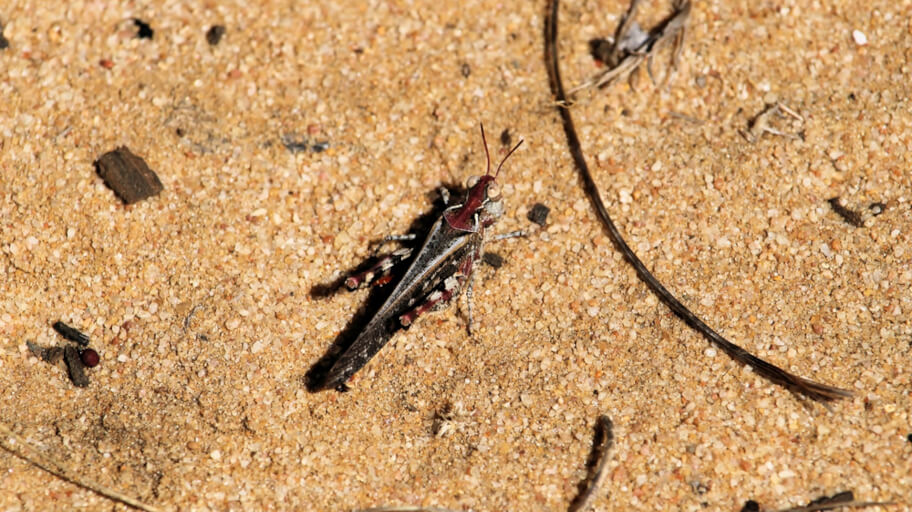
In excessive numbers, grasshoppers can cause a huge damage to your garden. Both adult and nymphs feed on grasses and broadleaf plants.
Grasshoppers are distinguished by strong chewing mouthparts, enlarged hind legs designed for jumping, and wings, which are missing in their immature stage – nymphs.
Organic Control Measures for Grasshoppers
Controlling this garden pest is difficult because of its migratory nature. However, there are several organic approaches to control grasshoppers.
 Handpick them or catch them in a butterfly net early in the morning when they are very slow moving.
Handpick them or catch them in a butterfly net early in the morning when they are very slow moving. Attract birds to your garden by providing a source of water and safe nesting sites. Birds are an effective control for numerous garden pests, including grasshoppers.
Attract birds to your garden by providing a source of water and safe nesting sites. Birds are an effective control for numerous garden pests, including grasshoppers. Plant insectary plants, such as clover, buckwheat, mustard, dill, cosmos, etc., to attract beneficial insects such as paper wasps, tachnid flies and robber flies which prey on grasshoppers.
Plant insectary plants, such as clover, buckwheat, mustard, dill, cosmos, etc., to attract beneficial insects such as paper wasps, tachnid flies and robber flies which prey on grasshoppers. Use physical barriers such as floating row covers to protect your plants.
Use physical barriers such as floating row covers to protect your plants. Use Nosema locustae or Beauveria bassiana, which are parasitic fungi species that infect and kill grasshoppers.
Use Nosema locustae or Beauveria bassiana, which are parasitic fungi species that infect and kill grasshoppers. Spray ornamental plants with Neem oil. It acts as a repellent and restricts growth.
Spray ornamental plants with Neem oil. It acts as a repellent and restricts growth. Spray your plants with Kaolin clay. It will help repel many types of insect pests, including grasshoppers.
Spray your plants with Kaolin clay. It will help repel many types of insect pests, including grasshoppers.
Hibiscus Beetle (Macoura concolor)
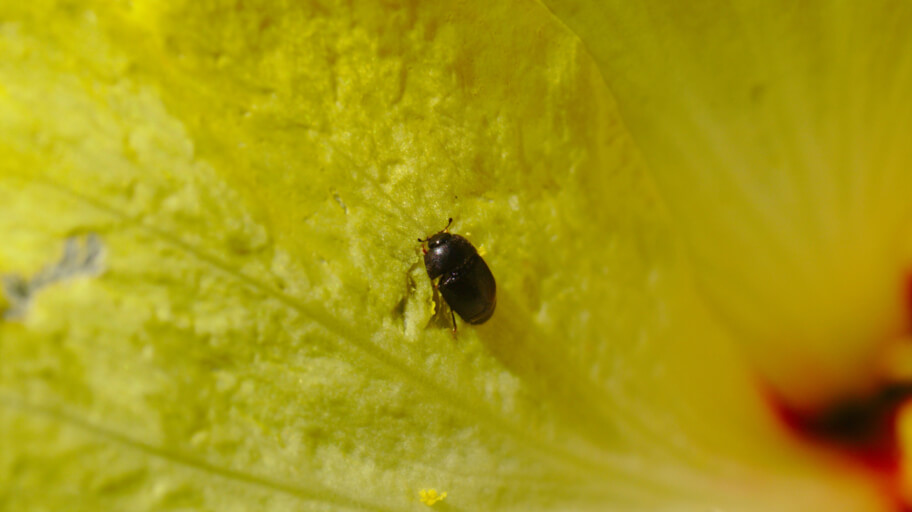
Hibiscus beetle is a pest of the hibiscus. It feeds on unopened and developing flower buds causing the damaged bud to drop from the plant prematurely. If you notice holes in the petals and prematurely fallen flowers it can be a sign of the beetle's presence.
The beetle is about 3mm long, oval in shape, and satin black in colour. It usually hides between the closed folds of the Hibiscus' petals, which makes its control very difficult. There are, however, a few strategies used by gardeners to reduce the beetle population.
 Pick up any fallen flowers every day.
Pick up any fallen flowers every day. Pour a mixture of water and liquid soap in white or yellow ice-cream containers and place the containers beneath your plants. Empty and refill the traps every few days.
Pour a mixture of water and liquid soap in white or yellow ice-cream containers and place the containers beneath your plants. Empty and refill the traps every few days.
Mealybug

Mealybugs are about 4mm long, soft-bodied and covered by white waxy coating insects of the Psuedococcidae family. They are a common garden pest that affects ornamental plants, citrus plants, ferns, orchids, greenhouse plants and trees. Mealybugs can usually be found in clusters underside of leaves and stem where they feed on plant juices. Feeding is accompanied by excreting of honeydew, which attracts ants and encourages sooty mould growth.
To spot mealybug infestation check under leaves and stem joints for fluffy white wax. When present in higher numbers, the symptoms of infestation are:
 leaf yellowing and curling
leaf yellowing and curling wilted plants
wilted plants sticky foliage due to the honeydew secreted by the mealybugs
sticky foliage due to the honeydew secreted by the mealybugs
Organic Pest Control Measures for Mealybugs
Here are a few methods to control and get rid of mealybugs:
 Blast the insects off the plants with a strong steam of water. This is an effective method to get rid of mealybugs when applied in the early stages of infestation. Spray the plants daily!
Blast the insects off the plants with a strong steam of water. This is an effective method to get rid of mealybugs when applied in the early stages of infestation. Spray the plants daily! Attract natural predators, such as ladybirds, lacewings and parasitic wasps, to control mealybugs by planting fennel, coreopsis, dill and bright flowers. Another beneficial insect is the mealybug destroyer (cryptolaemus montrouzieri) which can be purchased from garden shops.
Attract natural predators, such as ladybirds, lacewings and parasitic wasps, to control mealybugs by planting fennel, coreopsis, dill and bright flowers. Another beneficial insect is the mealybug destroyer (cryptolaemus montrouzieri) which can be purchased from garden shops. Dab rubbish alcohol or methylated spirits on the mealybugs. This will burn them but won’t harm your plants.
Dab rubbish alcohol or methylated spirits on the mealybugs. This will burn them but won’t harm your plants. Prune the affected plants if the infestation is light.
Prune the affected plants if the infestation is light. Apply insecticidal soap to the underside of leaves.
Apply insecticidal soap to the underside of leaves. Spray any infested areas with a mixture of equal parts of dishwashing liquid and water. The soap will suffocate the mealybugs.
Spray any infested areas with a mixture of equal parts of dishwashing liquid and water. The soap will suffocate the mealybugs. Spray the bugs with garlic or chilli soap.
Spray the bugs with garlic or chilli soap. Grow ant repellent plants to keep ants away from your garden. The ants protect the mealybugs from their predators.
Grow ant repellent plants to keep ants away from your garden. The ants protect the mealybugs from their predators.
Millipedes
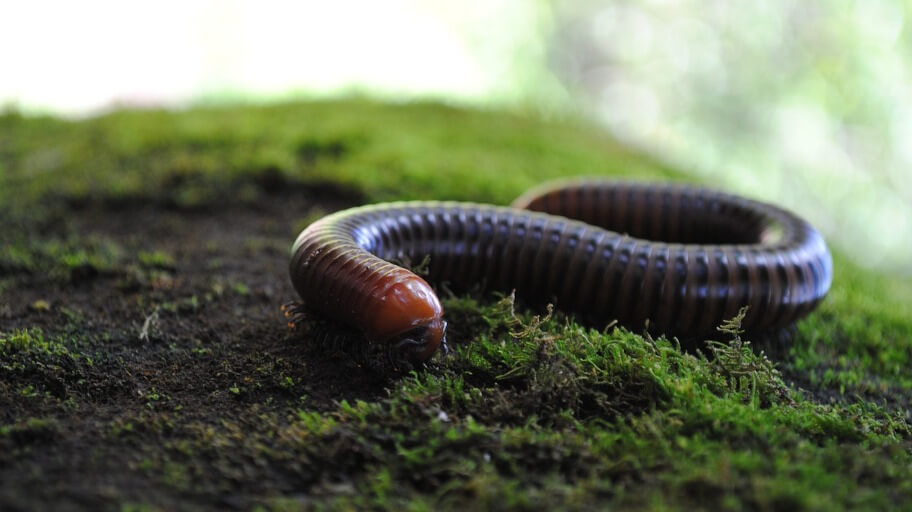
Millipedes are herbivores, feeding on decaying leaf litter, rotting wood and animal matter. Although Australian native millipedes are considered beneficial animals because of their role in breaking down organic matter in the soil, the black Portuguese millipede, which is introduced species to Australia, may turn into a garden pest by destroying seedlings, fruit and vegetable crops when reaches high population level.
How to Identify Millipedes
Portuguese millipede has a slate-grey to black smooth, cylindrical body with between 40 and 50 segments each of which with 2 pairs of legs. Adult millipedes are usually 20-45mm long. When disturbed, they curl up into a tight spiral and may release horrible smelling yellowish secretion.
Organic Control Measures for Millipedes
Signs of millipede damage include the stripping of the outer layers of a young plant stem and irregular damage to leaves. There are some things you can try against millipedes:
 Keep your garden clean to diminish food and areas of shelter.
Keep your garden clean to diminish food and areas of shelter. Apply insecticidal soap where you’ve seen them.
Apply insecticidal soap where you’ve seen them. Remove them by hand.
Remove them by hand.
Psyllids
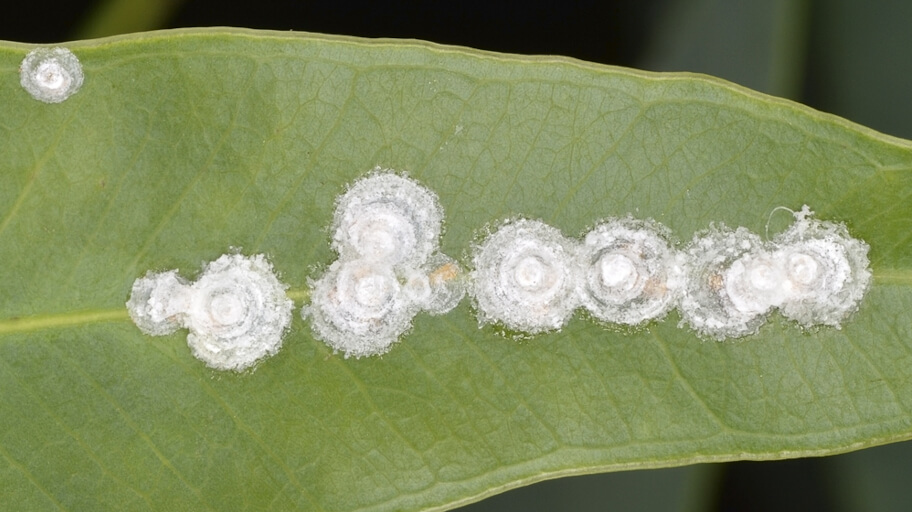
Psyllids are small sap sucking insects up to 4 mm in size and resemble miniature cicadas. They attack various crops including potato, carrot, citrus, pear, apple, gum trees, wattles, lillipilly and tomato. Each psyllid species feeds on a specific group of plants. They do the damage by sucking plant juices and excrete honeydew on which sooty mould grows. Some psyllid bugs use the honeydew to build a protective covering called lerp.
Damage and Symptoms of a Psyllids Infestation
Depending on the kind of psyllid the following symptoms may occur:
 premature leaf drop
premature leaf drop sooty mould
sooty mould discoloured leaves
discoloured leaves dimpled leaves with pockmarks
dimpled leaves with pockmarks yellow, severely distorted, dwarfed leaves and shoots
yellow, severely distorted, dwarfed leaves and shoots terminal dieback
terminal dieback
Organic Control Measures for Psyllids
To get rid of psyllids, you can try the following organic methods:
 Introduce beneficial insects, such as lacewings, ladybugs and parasitic wasps.
Introduce beneficial insects, such as lacewings, ladybugs and parasitic wasps. Apply kaolin clay to your plants. It acts as a protective barrier against insect pests.
Apply kaolin clay to your plants. It acts as a protective barrier against insect pests. Spray horticultural oil in early spring to kill overwintering adults and eggs.
Spray horticultural oil in early spring to kill overwintering adults and eggs. Spray Neem oil. Make sure to cover all leaves including their undersides.
Spray Neem oil. Make sure to cover all leaves including their undersides. Use insecticidal soap to deal with heavy infestations.
Use insecticidal soap to deal with heavy infestations.
Root-knot Nematodes (genus Meloidogyne)
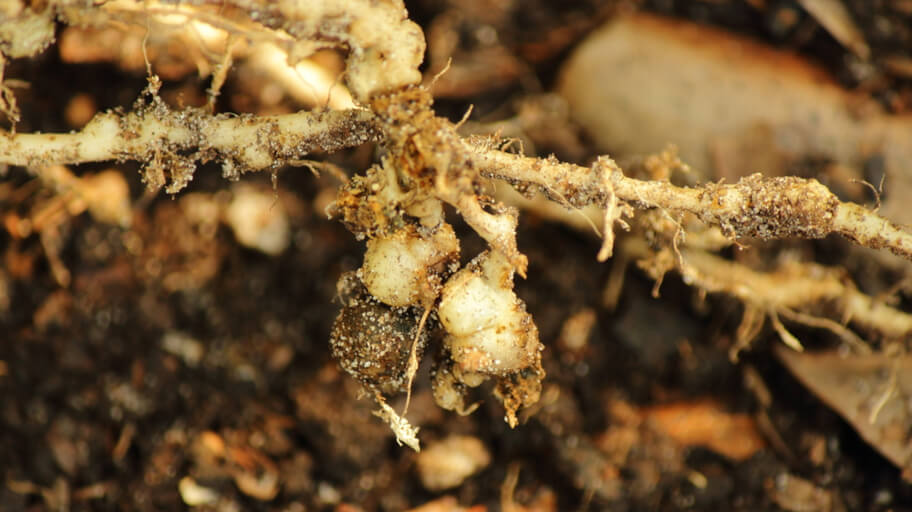
Root-knot nematodes are microscopic plant-parasitic roundworms that exist in the soil. They infect plant roots which stunt the plant's growth resulting in decreased yield or death of the plant. These parasitic nematodes have a wide host range, including many important vegetable, fruit and ornamental crops and some weed species as well. Different root-knot nematode species can be found in all mainland states of Australia.
Damage and Symptoms of Root-knot Nematode Infestation
Plants affected by root-knot nematode wouldn't have any specific above-ground symptoms. The general symptoms are stunting, yellowing or wilting, and they can be caused by many other root pathogens. Therefore, root must be checked for evidence of root-knot damage. Presence of root swelling or galls on the roots is a typical sign of infection. These galls should not be confused with rhizobium nodules that form on the roots of legumes.
Organic Control Measures for Nematodes
Some nematode controlling measures you can take are:
 Build a rich organic soil to encourage microorganisms which attack nematodes.
Build a rich organic soil to encourage microorganisms which attack nematodes. Sow mustard, canola, marigolds or BQ Mulch as a green manure. These plants release nematode deadly chemicals when chopped through the soil.
Sow mustard, canola, marigolds or BQ Mulch as a green manure. These plants release nematode deadly chemicals when chopped through the soil. Practice crop rotation with crops resistant to root-knot nematode.
Practice crop rotation with crops resistant to root-knot nematode. Remove infested roots as soon as the crop is harvested. Do not put the roots in the compost heap. Instead, seal them in a plastic bag and put it in the sun.
Remove infested roots as soon as the crop is harvested. Do not put the roots in the compost heap. Instead, seal them in a plastic bag and put it in the sun. Not all nematodes are garden pests, most of them are beneficial and are used to control plant pests.
Not all nematodes are garden pests, most of them are beneficial and are used to control plant pests.
Scale Insects

Scale insects are major pests on ornamental trees, orchards, indoor plants and even ferns. Some common species of scale insects in Australia are pink wax scale, black scale, soft brown scale and citrus red scale. They feed on the plant tissue by sucking the sap from leaves, stalks and stems, which can result in stunted plant growth, defoliation, and even death of the plant. Scales produce honeydew that encourages sooty mould growth.
How to Identify Scale Insects on Your Plants
There are two groups of scale insects - soft and armoured – and they range from 1 to 5 mm in size. Adult female scales do not move and stay permanently attached to the host plant. All scale species secrete a waxy coating for protection which makes it difficult to get rid of them. Scales are most susceptible to treatment during their juvenile stage when they are missing their protective coating.
Signs that may indicate an infestation of scale pests are:
 bumps similar to shells on the undersides of leaves
bumps similar to shells on the undersides of leaves presence of honeydew and sooty mould
presence of honeydew and sooty mould distorted or stunted fruit
distorted or stunted fruit dieback of twigs and branches
dieback of twigs and branches yellow spots on leaves and defoliation
yellow spots on leaves and defoliation
Organic Pest Control Measures for Scale Insects
Here are a handful of organic strategies to control scales in your home and garden:
 Dispose of infested plants and replace them;
Dispose of infested plants and replace them; Use a damp cloth to rub off scale insects from the plant in case of minor infestation.
Use a damp cloth to rub off scale insects from the plant in case of minor infestation. Spray the infested plants with horticultural soap.
Spray the infested plants with horticultural soap. Encourage natural predators of scale, such as scale-eating ladybird, lacewings and parasitic wasps, by growing suitable flowers. These beneficial insects will also help you control other garden pests.
Encourage natural predators of scale, such as scale-eating ladybird, lacewings and parasitic wasps, by growing suitable flowers. These beneficial insects will also help you control other garden pests. Keep ants away as they protect the scales from their natural enemies. Use horticultural glues to cut off ants’ way to the tops of trees.
Keep ants away as they protect the scales from their natural enemies. Use horticultural glues to cut off ants’ way to the tops of trees.
Slaters

Slaters (also known as pill bugs, woodlice and Role Poleys) are usually considered beneficial because they feed on decaying organic matter, and that way, help build soil. However, in high numbers, they can shift to crop seedlings, and thus, becoming a problem for gardeners.
How to Identify Pill Bugs
Slaters can be found all over Australia. Although there are different species, they all have a similar appearance – armoured, flattened, segmented bodies, gray/brown in colour with 1 pair of legs per segment. Their size vary but generally is less than 20mm.
Damage
Damage caused by slaters result in ring-barking of stems and young branches, as well as, uneven rasping-type damage similar to the damage caused by slugs and snails. To find them, check under rocks, pots, stubble residue, or scrape back the mulch. These are the usual places where slaters seek refuge during the day.
Organic Control Measures for Slaters
Even at high densities, it is not certain that slaters will attack your crops. Because of their beneficial role, it's best to manage them. Here is a few suggestion by Josh Byrne, author of The Green Gardener, how to do that:
 Keep mulch clear of the furrow when sowing seed.
Keep mulch clear of the furrow when sowing seed. Make traps by placing orange shells or cut potato between two thick layers of damp newspapers. Place the traps in a moist place in your garden. Trapped slaters can be fed to your chooks.
Make traps by placing orange shells or cut potato between two thick layers of damp newspapers. Place the traps in a moist place in your garden. Trapped slaters can be fed to your chooks. Place old pots with the bottom chopped out around seedlings to protect them from slaters. Once the stems become tougher, you can remove them.
Place old pots with the bottom chopped out around seedlings to protect them from slaters. Once the stems become tougher, you can remove them. Keep plants and fruit off the ground. For example, you can grow strawberries in pots.
Keep plants and fruit off the ground. For example, you can grow strawberries in pots.
Snails and Slugs

All garden pest snails and slugs are introduced to Australia and can pose a huge threat to your garden plants. They damage seedlings, leaves, fruit, underground tubers and plant seeds which can result in major production losses. Probably the most common garden pests of these are the brown snail (Helix aspera) and the grey field slug (Deroceras reticulatum).
Snails thrive in a moist environment. They avoid the sun and seek cooler spots to wait for the night when they are most active. When the weather is dry or cold, they seal their shells and can remain dormant for several years.
Signs of possible infestation of snails and slugs are:
 big holes in leaves
big holes in leaves completely destroyed seedlings, especially veggies and herbs
completely destroyed seedlings, especially veggies and herbs shiny silver trails
shiny silver trails
Organic Control Measures for Snails and Slugs
There are many different ways to control snails. Here are some environmentally sound methods:
 Clean up potential breeding sites to reduce snails.
Clean up potential breeding sites to reduce snails. Handpick and submerge them into a bucket with soapy water.
Handpick and submerge them into a bucket with soapy water. Use organic sprays made of Quassia amara or other plants that deter snails and slugs, such as garlic and wormwood.
Use organic sprays made of Quassia amara or other plants that deter snails and slugs, such as garlic and wormwood. Spray a coffee mix (one part fresh espresso to five parts water) to the plants and mulch where slugs and snails are a problem. The caffeine in the coffee kills these pests.
Spray a coffee mix (one part fresh espresso to five parts water) to the plants and mulch where slugs and snails are a problem. The caffeine in the coffee kills these pests. Place a bowl of beer in a strategic location in your garden. Beer attracts snails and slugs, making them crawl into the bowl and drown.
Place a bowl of beer in a strategic location in your garden. Beer attracts snails and slugs, making them crawl into the bowl and drown. Build barriers to protects vulnerable plants. Suitable materials include crushed eggshells, wood ash, sawdust, lime and wood shavings.
Build barriers to protects vulnerable plants. Suitable materials include crushed eggshells, wood ash, sawdust, lime and wood shavings. Use copper tape as individual collars around pots or raised garden beds. Copper repels snails.
Use copper tape as individual collars around pots or raised garden beds. Copper repels snails.
Spider Mites (Tetranychidae family)

There is a wide variety of spider mites, many of which feed on plants, and a few of those can be considered as major pests. One of the most well-known species is the red spider mite also known as twospotted spider mite. Mites reproduce rapidly in warm weather and can cause a severe damage in a short period of time.
Damage and Symptoms of a Spider Mite Infestation
Spider mites feed on the underside of leaves forming dense colonies. These pest use their mouthparts (a.k.a chelicerae) to penetrate the leaf and suck up the discharged sap. Many spider mite species spin webbing to protect themselves from predators while they feed and breed. Symptoms of mite infestation show up as:
 yellow spots on the leaf top;
yellow spots on the leaf top; stripping around leaf veins;
stripping around leaf veins; leaves feel gritty when rubbed;
leaves feel gritty when rubbed; silken webbing;
silken webbing; defoliation (in case of severe infestation)
defoliation (in case of severe infestation)
Organic Control Measures for Spider Mites
Mites feed on many kinds of plants, including vegetables, fruit trees, vines and ornamental plants. Some organic solutions to control the mites in your garden include:
 Introducing of natural enemies such as predatory bugs, ladybirds, lacewings and predatory mites.
Introducing of natural enemies such as predatory bugs, ladybirds, lacewings and predatory mites. Removing the affected leaves.
Removing the affected leaves. Keeping plants well watered to discourage mites as they prefer hot and dry conditions.
Keeping plants well watered to discourage mites as they prefer hot and dry conditions. Flushing the plants thoroughly with horticultural oil or insecticidal soap. Focus on the undersides of leaves.
Flushing the plants thoroughly with horticultural oil or insecticidal soap. Focus on the undersides of leaves. Using a strong stream of water to knock the mites off the plant. Apply early in the morning for several days in a row.
Using a strong stream of water to knock the mites off the plant. Apply early in the morning for several days in a row.
Thrips

Thrips are small, slender insects (0.5mm – 15mm long) that range in colour from white to yellow to black. Although, there are more than 6000 known species of thrips, only a few are important pests of plants. Some common pest thrips in Australia are Plague thrips (Thrips imaginis), Tomato thrips (Frankliniella schultzei), and Western Flower Thrips (Frankliniella occidentalis).
Damage and Symptoms of Thrips Infestations
Thrips are sap suckers and attack a large variety of plants. They cause significant damage to flowers, foliage, and fruit when feeding. Some species spread plant viruses, such as Tospoviruses. Symptoms of thrip infestation are:
 silvering and flecking appearance on leaves;
silvering and flecking appearance on leaves; deformed and stunted flowers and shoots;
deformed and stunted flowers and shoots; flower drop;
flower drop; browning of petals and fruit
browning of petals and fruit
Organic Control Measures for Thrips
Organic measures to prevent and control thrips:
 Remove weeds and crop debris from the garden as they can host thrips.
Remove weeds and crop debris from the garden as they can host thrips. Remove any infested plants.
Remove any infested plants. Attract beneficial insects, such as ladybugs, lacewings, minute pirate bugs and predatory mites.
Attract beneficial insects, such as ladybugs, lacewings, minute pirate bugs and predatory mites. Use blue and yellow sticky traps to capture adult thrips.
Use blue and yellow sticky traps to capture adult thrips. Use thrips proof mesh.
Use thrips proof mesh. Spray dormant oil on fruit trees.
Spray dormant oil on fruit trees. Spray insecticidal soap or Neem oil.
Spray insecticidal soap or Neem oil.
Tree Borers
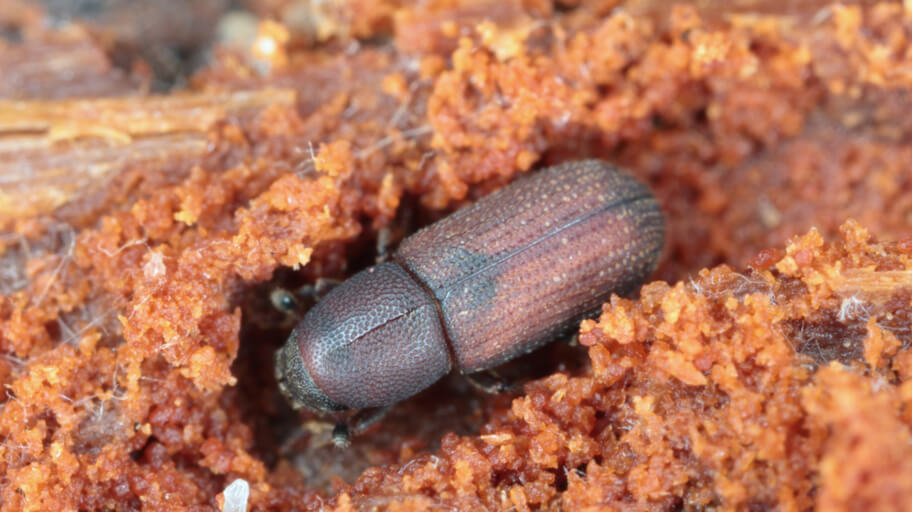
Borers are actually the larval stage of different insects, such as beetles, weevils, moths, or sawfly, which lay their eggs in trees, usually trees that are under stress. Once hatched, the young larvae start eating the tree in or under the bark which interrupts the flow of sap and eventually kills the tree. Since borers are attracted to weak trees, by taking good care for your trees you should be able to keep the borers away from your garden.
How to Identify Tree Borers
Trees with frass or webbing around a hole in the trunk indicates borer presence. To identify what type of borer you are dealing with, look for:
 Clearwing moths leave large open tunnels filled with sawdust-like frass;
Clearwing moths leave large open tunnels filled with sawdust-like frass; Bark beetles create many tiny holes in tree branches and trunks;
Bark beetles create many tiny holes in tree branches and trunks; Wet spots and dark stains and D-shaped emergence holes may indicate roundheaded or flatheaded borers;
Wet spots and dark stains and D-shaped emergence holes may indicate roundheaded or flatheaded borers;
Organic Control Measures for Tree Borers
Here are some no chemical ways to manage tree borers:
 Improve the health of the tree to combat borers. A healthy tree can drown borers in sap.
Improve the health of the tree to combat borers. A healthy tree can drown borers in sap. Prune branches affected by boring beetles.
Prune branches affected by boring beetles. Moth larvae may be killed by pushing a piece of wire or straightened out safety pin into the holes.
Moth larvae may be killed by pushing a piece of wire or straightened out safety pin into the holes. If a tree is damaged beyond healing, remove the tree and focus on protecting the rest trees of the same type around it.
If a tree is damaged beyond healing, remove the tree and focus on protecting the rest trees of the same type around it.
Weevils

There are numerous species of weevils that are considered pests because of the damage they can cause to all grain and vegetable crops. They vary in colour and size but all adult weevils share one distinguishing feature – an extended snout or rostrum on the head. The weevil larvae are also easy to identify through their distinct brown heads and creamy-coloured, legless bodies.
Damage and Symptoms of Weevil Infestation
Both adults and larvae cause damage. While larvae are found in soil where they feed on plant roots, mature weevils prefer the taste of the green plants' foliage. A weevil infestation is characterised by the following signs:
 scalloped-shaped holes along the leaf margin;
scalloped-shaped holes along the leaf margin; ring-barking of young plants;
ring-barking of young plants; loss of plant vigour;
loss of plant vigour; munched roots;
munched roots; adults crawling up the stems and trunks of plants
adults crawling up the stems and trunks of plants
Organic Control Measures for Weevils
To control the number of weevils in your garden, you could try to:
 Water your plants only when necessary because moist soil attracts weevils.
Water your plants only when necessary because moist soil attracts weevils. Put aluminium foil, horticultural glue or greasy hessian sacks around the trunk of susceptible trees to catch adult weevils when trying to climb.
Put aluminium foil, horticultural glue or greasy hessian sacks around the trunk of susceptible trees to catch adult weevils when trying to climb. Place a large tarp under the infested trees and shake. The weevils will fall onto the tarp and can then be collected in a container of soapy water. The soapy water will kill them.
Place a large tarp under the infested trees and shake. The weevils will fall onto the tarp and can then be collected in a container of soapy water. The soapy water will kill them. Place a shallow pan of water in the garden. The weevils will climb into it and drown.
Place a shallow pan of water in the garden. The weevils will climb into it and drown. Handpick the adult weevils and put them in a jar of soapy water.
Handpick the adult weevils and put them in a jar of soapy water. Rotate your crops whenever possible.
Rotate your crops whenever possible. Remove debris and weeds from your garden to eliminate rest areas for weevils and other garden pests.
Remove debris and weeds from your garden to eliminate rest areas for weevils and other garden pests. Use protective row covers on vegetable plants when in seedling stages.
Use protective row covers on vegetable plants when in seedling stages. Introduce chickens, ducks and guinea fowl to your garden. These birds can reduce weevil numbers over time.
Introduce chickens, ducks and guinea fowl to your garden. These birds can reduce weevil numbers over time.
White Curl Grubs

White curl grubs are the larvae of different beetles including African black beetle, Christmas beetle, Scarab beetle and cockchafers. They feed on dead plant material and live plant roots and can cause severe damage to lawns, gardens and potted plants. They are most active during periods of dry weather, usually around Christmas in Australia.
How to Identify White Curl Grubs
White curl grubs have a creamy-white body with a brown coloured head and greyish tail end due to the ingested soil. They grow to around 40mm long and are often mistaken for “witchetty grubs”. When disturbed, these grubs curl up into a “C” shape which gave them their common name.
Symptoms that accompany an infestation of white curl grubs are:
 Dead patches of grass in the lawn. Grass can be pulled out with ease.
Dead patches of grass in the lawn. Grass can be pulled out with ease. Stunted growth of potted plants. The entire root system can be munched away.
Stunted growth of potted plants. The entire root system can be munched away. Slow development of garden plants for no obvious reason. Dig up the soil around those plants and look for curl grubs.
Slow development of garden plants for no obvious reason. Dig up the soil around those plants and look for curl grubs.
Organic Control Measures White Curl Grubs
 Pour a mixture of biodegradable detergent and water on the affected spots. This will force the grubs to the surface. Birds will do the rest.
Pour a mixture of biodegradable detergent and water on the affected spots. This will force the grubs to the surface. Birds will do the rest. Keep the lawn healthy and well-watered during spring and summer to prevent adult beetles laying eggs on your lawn.
Keep the lawn healthy and well-watered during spring and summer to prevent adult beetles laying eggs on your lawn. Drench the soil with organic insecticides. Apply during mid spring to mid summer to kill the hatched larvae.
Drench the soil with organic insecticides. Apply during mid spring to mid summer to kill the hatched larvae. Use tea tree oil or molasses mixture to get rid of the grubs.
Use tea tree oil or molasses mixture to get rid of the grubs. Turn over the soil to expose the curl grubs. Handpick them and feed to the poultry.
Turn over the soil to expose the curl grubs. Handpick them and feed to the poultry. Reduce the use of outdoor night lighting to avoid attracting adult beetles which will lay their eggs in your garden.
Reduce the use of outdoor night lighting to avoid attracting adult beetles which will lay their eggs in your garden.
Whitefly
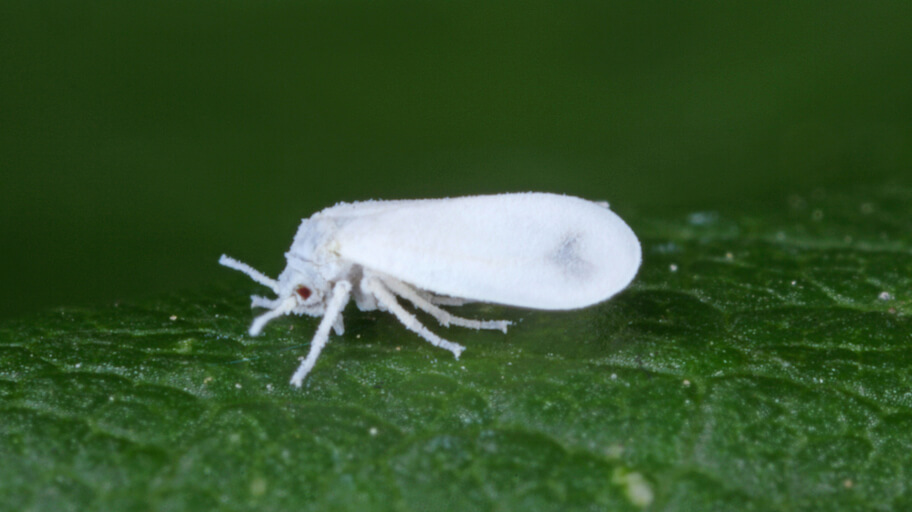
Whiteflies are small, sap-sucking insects from the family Aleyrodidae and are relatives of aphids, mealybugs and leafhoppers. They resemble small moths with wings covered in a powdery white wax and are often found on the underside of leaves. Whiteflies can infest a wide range of plants and vegetable crops including melon, eggplant, bean, cabbage, tomato and broccoli.
There are several different species of whiteflies in Australia but the two most common pest species found in home gardens are the Silverleaf whitefly (Bemisia tabaci) and the greenhouse whitefly (Trialeurodes vaporariorum).
Damage and Symptoms of Whitefly Infestation
Both the nymph and adult suck the plant juice causing stunting, silvering or yellowing of leaves, wilting, and yield reduction. Whiteflies produce a sticky, sugary substance called honeydew on which black sooty mould can develop. These pest insects tend to fly in clouds when the infested plant is disturbed, so you can easily spot their presence.
Organic Control Measures For Whiteflies
Getting rid of whiteflies might not be easy as they quickly develop insecticide resistance. Your best bet would be to tackle the problem as soon as you notice it. Here are some useful organic methods you can try:
 Remove infested leaves while the number of whiteflies is still low.
Remove infested leaves while the number of whiteflies is still low. Hose the insects down with water for several days in a row. Effective only in the early stage of infestation.
Hose the insects down with water for several days in a row. Effective only in the early stage of infestation. Use a handheld vacuum cleaner to suck up the adult whiteflies. Put the ‘trash’ in a plastic bag and freeze for 24 hours before discarding.
Use a handheld vacuum cleaner to suck up the adult whiteflies. Put the ‘trash’ in a plastic bag and freeze for 24 hours before discarding. Use yellow sticky traps near infested plants.
Use yellow sticky traps near infested plants. Plant marigolds and alyssum near susceptible plants to attract natural predators such as lacewings, ladybirds, and hoverflies.
Plant marigolds and alyssum near susceptible plants to attract natural predators such as lacewings, ladybirds, and hoverflies. Release parasitic wasps. They can be purchased.
Release parasitic wasps. They can be purchased. Spray with botanical insecticides made of hot chilli or garlic. Make sure to cover the undersides of leaves.
Spray with botanical insecticides made of hot chilli or garlic. Make sure to cover the undersides of leaves. Use potassium soap sprays or neem oil.
Use potassium soap sprays or neem oil.
The material provided in this article is based on the best available information at the time of publishing. We, at Fantastic Gardeners Melbourne, advise you to avoid acting on the basis of the content of this publication without first obtaining independent, professional opinion.




